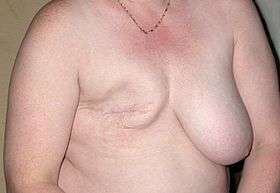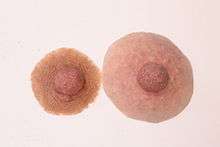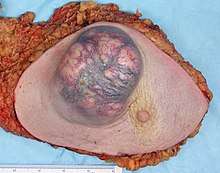Mastectomy
Mastectomy is the medical term for the surgical removal of one or both breasts, partially or completely. A mastectomy is usually carried out to treat breast cancer.[1] In some cases, people believed to be at high risk of breast cancer have the operation as a preventive measure. Alternatively, some people can choose to have a wide local excision, also known as a lumpectomy, an operation in which a small volume of breast tissue containing the tumor and a surrounding margin of healthy tissue is removed to conserve the breast.
| Mastectomy | |
|---|---|
 Person following a mastectomy | |
| ICD-9-CM | 85.4 |
| MeSH | D008408 |
| MedlinePlus | 002919 |
Both mastectomy and lumpectomy are referred to as "local therapies" for breast cancer, targeting the area of the tumor, as opposed to systemic therapies, such as chemotherapy, hormonal therapy, or immunotherapy.
Traditionally, in the case of breast cancer, the whole breast was removed. Currently, the decision to do the mastectomy is based on various factors, including breast size, the number of lesions, biologic aggressiveness of a breast cancer, the availability of adjuvant radiation, and the willingness of the patient to accept higher rates of tumor recurrences after lumpectomy and radiation. Outcome studies comparing mastectomy to lumpectomy with radiation have suggested that routine radical mastectomy surgeries will not always prevent later distant secondary tumors arising from micro-metastases prior to discovery, diagnosis, and operation.
Medical uses
Despite the increased ability to offer breast conservation techniques to patients with breast cancer, certain groups may be better served by traditional mastectomy procedures including:
- women who have already had radiation therapy to the affected breast
- women with 2 or more areas of cancer in the same breast that are too far apart to be removed through 1 surgical incision, while keeping the appearance of the breast satisfactory
- women whose initial lumpectomy along with (one or more) re-excisions has not completely removed the cancer
- women with certain serious connective tissue diseases such as scleroderma, which make them especially sensitive to the side effects of radiation therapy
- pregnant women who would require radiation while still pregnant (risking harm to the child)
- women with a tumor larger than 5 cm (2 inches) that doesn't shrink very much with neoadjuvant chemotherapy
- women with cancer that is large relative to their breast size
- women who have tested positive for a deleterious mutation on the BRCA1 or BRCA2 gene and opt for a preventive mastectomy since they are at high risk for the development of breast cancer.
- men with gynecomastia
- transgender individuals suffering from dysphoria will sometimes elect for mastectomy
Side effects
According to cancer.org, aside from the post-surgical pain and the obvious change in the shape of the breast(s), possible side effects of a mastectomy include wound infection, hematoma (buildup of blood in the wound), and the seroma (buildup of clear fluid in the wound). If the lymph nodes are also removed, additional side effects may occur.[2]
Types
Currently, there are several surgical approaches to mastectomy, and the type that a person decides to undergo (or whether she or he will decide instead to have a lumpectomy) depends on factors such as the size, location, and behavior of the tumor (if one is present), whether or not the surgery is prophylactic, and whether the person intends to undergo reconstructive surgery.[3]
- Simple mastectomy (or "total mastectomy"): In this procedure, the entire breast tissue is removed, but axillary contents are undisturbed. Sometimes the "sentinel lymph node"—that is, the first axillary lymph node that the metastasizing cancer cells would be expected to drain into—is removed. People who undergo a simple mastectomy can usually leave the hospital after a brief stay. Frequently, a drainage tube is inserted during surgery in their chest and attached to a small suction device to remove subcutaneous fluid. These are usually removed several days after surgery as drainage decrease to less than 20-30 ml per day. People that are more likely to have the procedure of a simple or total mastectomy are those that have large areas of ductal carcinoma in situ or even those persons that are removing the breast because of the possibility of breast cancer occurring in the future (prophylactic mastectomies). When this procedure is done on a cancerous breast, it is sometimes also done on the healthy breast to forestall the appearance of cancer there. The choice of this "contralateral prophylactic" option has become more typical in recent years in California, most notable in people younger than 40, climbing from just 4 percent to 33 percent from 1998 to 2011. However, the possible benefits appear to be marginal at best in the absence of genetic indicators, according to a large-scale study published in 2014.[4][5][6] For healthy people known to be at high risk for breast cancer, this surgery is sometimes done bilaterally (on both breasts) as a cancer-preventive measure.
- Modified radical mastectomy: The entire breast tissue is removed along with the axillary contents (fatty tissue and lymph nodes). In contrast to a radical mastectomy, the pectoral muscles are spared. This type of mastectomy is used to examine the lymph nodes because this helps to identify whether the cancer cells have spread beyond the breasts.[3]
- Radical mastectomy (or "Halsted mastectomy"): First performed in 1882, this procedure involves removing the entire breast, the axillary lymph nodes, and the pectoralis major and minor muscles behind the breast. This procedure is more disfiguring than a modified radical mastectomy and provides no survival benefit for most tumors. This operation is now reserved for tumors involving the pectoralis major muscle or recurrent breast cancer involving the chest wall. It is only recommended for breast cancer that has spread to the chest muscles. Radical mastectomies have been reserved for only those cases because they can be disfiguring and modified radical mastectomies have been proven to be just as effective.[3]
- Skin-sparing mastectomy: In this surgery, the breast tissue is removed through a conservative incision made around the areola (the dark part surrounding the nipple). The increased amount of skin preserved as compared to traditional mastectomy resections serves to facilitate breast reconstruction procedures. People with cancers that involve the skin, such as inflammatory cancer, are not candidates for skin-sparing mastectomy.
- Nipple-sparing/subcutaneous mastectomy: Breast tissue is removed, but the nipple-areola complex is preserved. This procedure was historically done only prophylactically or with mastectomy for the benign disease over the fear of increased cancer development in retained areolar ductal tissue. Recent series suggest that it may be an oncologically sound procedure for tumors not in the subareolar position.[7][8][9]
- Extended Radical Mastectomy: Radical mastectomy with intrapleural en bloc resection of internal mammary lymph node by sternal splitting.[10]
- Prophylactic mastectomy: This procedure is used as a preventive measure against breast cancer. The surgery is aimed to remove all breast tissue that could potentially develop into breast cancer. The surgery is generally considered when the person has BRCA1 or BRCA2 mutations in their genes. The tissue from just beneath the skin to the chest wall and around the borders of the breast needs to be removed from both breasts during this procedure. Because breast cancer develops in the glandular tissue, the milk ducts and milk lobules must be removed also. Because the region is so large-ranging, from the collarbone to the lower rib margin and from the middle of the chest around the side and under the arm, it is very difficult to remove all of the tissue. This genetic mutation is a high-risk factor for the development of breast cancer, family history, or atypical lobular hyperplasia (when irregular cells line the milk lobes.) This type of procedure is said to reduce the risk of breast cancer by 100%. However, other circumstances may affect the outcome. Studies have shown that pre-menopausal women have had a higher survival rate after this procedure had been done.[11]
 Examples of custom nipple prostheses
Examples of custom nipple prostheses- Breast prostheses used by some women after mastectomy
 Mastectomy specimen containing a very large cancer of the breast (in this case, an invasive ductal carcinoma)
Mastectomy specimen containing a very large cancer of the breast (in this case, an invasive ductal carcinoma) Typical macroscopic (gross examination) appearance of the cut surface of a mastectomy specimen containing cancer, in this case, an invasive ductal carcinoma of the breast, pale area at the center
Typical macroscopic (gross examination) appearance of the cut surface of a mastectomy specimen containing cancer, in this case, an invasive ductal carcinoma of the breast, pale area at the center
Before surgery
Before the operation, everyone will meet with the surgeon a few days before the surgery or even the day before, however, a much longer period is very beneficial since it allows the patient for a more objective weighing of the options. Although there is some urgency in timing the surgery, the patient needs some time after the initial shock of hearing the cancer verdict; otherwise, she may later regret her decision. The extent and specific details regarding the mastectomy will be discussed along with the person's medical history.
Of extreme importance will be the woman's decision whether the entire breast is to be removed, or only a part of it - and that is usually much more a personal choice than a medical assessment. The medical viewpoint stresses the statistical fact of much stronger chances for cure and survival when the breast is removed completely, even when the size of the cancer is small. From the personal viewpoint, the perspective of not having the breast is very painful and difficult to accept. At this point the support of the family and of good friends can make the difference between life and death, since it is easier for friends to present the after-the-surgery future in the "matter of fact" way, thus facilitating the reasonable decision. The dilemma of the vital importance will be weighing the aesthetics and pride, against the chances of curing and surviving, which are much better when the breast is removed 100% completely. During these considerations, very painful indeed, one needs to realize that a woman's flat chest without breasts, even without nipples, does not look bad at all, nothing to feel embarrassed of, or to be ashamed by; it looks just neutral. Since the surgery is unavoidable, for people open to see the problem in this way, the choice becomes easier.
Before the surgery the patient will have time to ask any questions regarding the procedure at this time and after everything is addressed a consent form is signed. Information about not eating or drinking anything beforehand will be gone over as well. The person will also meet with the anesthesiologist or the health professional who is going to be giving the anesthesia the day of the operation.[2]
Recent research has indicated that mammograms should not be done with any increased frequency than normal procedure in people undergoing breast surgery, including breast augmentation, mastopexy, and breast reduction.[12]
During surgery
The day of the operation the patient will have an IV line started, which will be used to give medicine. Since this is an extensive procedure the patient will be hooked up to an EKG machine and also have a blood pressure cuff to monitor vitals and the heart rhythm throughout the whole surgery. The anesthesia will be given, which will result in the person going to sleep. The timing of the surgery all depends on the extent and what type of mastectomy the patient will be having.[2]
After surgery
When the procedure is complete the patient will be taken to a recovery room where they are monitored until they wake up and their vital signs remain stable. It is normal for people that have mastectomies to remain in the hospitals for 1 to 2 nights and they are released to go home if they are doing well. The decision for discharge should be made by the doctor based on the person's overall health at the time. The person is dressed with a bandage over the surgery site that is wrapped around the chest snugly. It is common to have drains coming from the incision site to help remove blood and lymph to initiate the healing process. Patients may have to be taught to empty, care, and measure the fluid from the drains. Measuring the fluids will help identify any problems the doctors need to be aware of. Patients should be taught the effects of the surgery, such as regular activity may be altered. There is a possibility that pain, numbness, or tingling in the chest and arm could continue long after the surgery has been done. It is recommended that patients see their surgeon 7–14 days after the surgery, during this time the doctor will explain the results and talk about further treatment if needed such as radiation and chemotherapy. The doctor might refer the patient to a plastic surgeon if she showed interest in breast reconstruction surgery.[2]
Trends
Between 2005 and 2013, the overall rate of mastectomy increased 36 percent, from 66 to 90 per 100,000 adult women. The rate of hospital-based bilateral mastectomies (inpatient and outpatient combined) more than tripled, from 9.1 to 29.7 per 100,000 adult women, whereas the rate of unilateral mastectomies remained relatively stable at around 60 per 100,000 women. From 2005 to 2013, the rate of bilateral outpatient mastectomies increased more than fivefold and the inpatient rate nearly tripled. The rate of unilateral mastectomies nearly doubled in the outpatient setting but decreased 28 percent in the inpatient setting. By 2013, nearly half of all mastectomies were performed outpatient.[13]
Frequency
Mastectomy rates vary tremendously worldwide, as was documented by the 2004 'Intergroup Exemestane Study',[14] an analysis of surgical techniques used in an international trial of adjuvant treatment among 4,700 females with early breast cancer in 37 countries. The mastectomy rate was highest in central and eastern Europe at 77%. The USA had the second highest rate of mastectomy with 56%, western and northern Europe averaged 46%, southern Europe 42% and Australia and New Zealand 34%.
History
Mastectomy for breast cancer was performed at least as early as 548 AD, when it was proposed by the court physician Aëtius of Amida to Theodora. She declined the surgery, and died a few months later.[15] Al-Zahrawi, a tenth century Arab physician sometimes referred to as the "Father of surgery",[16] described what is thought to be the first attempt at reduction mammaplasty for the management of gynaecomastia.[16]
Female members of the Skoptsy sect in the Russian Empire also practiced mastectomy as a ritual alongside castration for men, in accordance with their belief that sexual desire was evil.[17]
The first picture of the results of breast cancer surgery was on the cover of the New York Times in 1993 by Winstein. This real picture of Matuschka with her scar outraged people.[18]
Society and culture
In recent years, designers have catered to the medical market and those affected by the surgical procedure. Many dresses designed with this market in mind have built-in padded cups or have pouches so that inserts of various sizes can be placed in either or both cups of the garment. Some fashion designers even produce mastectomy swimwear with a similar format in mind[19]
The term is from Greek μαστός "breast" and ἐκτομή ektomia "cutting out".
See also
- Breast reconstruction
- Breast cancer management
- Sex reassignment surgery (female-to-male)
- List of surgeries by type
| Classification |
|
|---|
References
- "Mastectomy | Lumpectomy | Breast Cancer | MedlinePlus". Retrieved 2018-11-07.
- "Surgery for Breast Cancer." Surgery for Breast Cancer. N.p., n.d. Web. 02 Aug. 2014.
- "What Is Mastectomy?". May 16, 2013. Retrieved September 13, 2014.
- Lindsey Tanner (September 2, 2014). "Double mastectomy doesn't boost survival for most". AP. Retrieved September 13, 2014.
- Lisa A. Newman (2014). "Contralateral Prophylactic Mastectomy—Is It a Reasonable Option?". JAMA. 312 (9): 895–897. doi:10.1001/jama.2014.11308. PMID 25182096.
- Allison W. Kurian with five others (2014). "Use of and Mortality After Bilateral Mastectomy Compared With Other Surgical Treatments for Breast Cancer in California, 1998-2011". JAMA. 312 (9): 902–914. doi:10.1001/jama.2014.10707. PMC 5747359. PMID 25182099.
- Gerber B, Krause A, Reimer T, et al. (2003). "Skin-sparing mastectomy with conservation of the nipple-areola complex and autologous reconstruction is an oncologically safe procedure". Ann. Surg. 238 (1): 120–7. doi:10.1097/01.SLA.0000077922.38307.cd. PMC 1422651. PMID 12832974.
- Mokbel R, Mokbel K (2006). "Is it safe to preserve the nipple areola complex during skin-sparing mastectomy for breast cancer?". Int J Fertil Female's Med. 51 (5): 230–2. PMID 17269590.
- Sacchini V, Pinotti JA, Barros AC, et al. (2006). "Nipple-sparing mastectomy for breast cancer and risk reduction: oncologic or technical problem?". J. Am. Coll. Surg. 203 (5): 704–14. doi:10.1016/j.jamcollsurg.2006.07.015. PMID 17084333.
- Noguchi, M; Sakuma, H; Matsuba, A; Kinoshita, H; Miwa, K; Miyazaki, I (1983). "Radical mastectomy with intrapleural en bloc resection of internal mammary lymph node by sternal splitting". The Japanese Journal of Surgery. 13 (1): 6–15. doi:10.1007/bf02469683. PMID 6887660.
- "Preventive Mastectomy for Breast Cancer." WebMD. WebMD, n.d. Web. 04 Aug. 2014.
- American Society of Plastic Surgeons (24 April 2014), "Five Things Physicians and Patients Should Question", Choosing Wisely: an initiative of the ABIM Foundation, American Society of Plastic Surgeons, archived from the original on 19 July 2014, retrieved 25 July 2014
- Steiner, C.A.; Weiss, A.J.; Barrett, M.L.; Fingar, K.R.; Davis, P.H (2016). "Trends in Bilateral and Unilateral Mastectomies in Hospital Inpatient and Ambulatory Settings, 2005–2013" (PDF). HCUP Statistical Brief #201: 1–14. Retrieved 7 March 2016.
- "Federation of European Cancer Societies". Archived from the original on 2007-11-28. Retrieved 2007-12-03.
- Olson, James Stuart (2002). Bathsheba's breast: women, cancer & history. Baltimore: The Johns Hopkins University Press. p. 11. ISBN 0-8018-6936-6.
- Ahmad, Z. (St Thomas' Hospital) (2007), "Al-Zahrawi – The Father of Surgery", ANZ Journal of Surgery, 77 (Suppl. 1): A83, doi:10.1111/j.1445-2197.2007.04130_8.x
- "From Heresy to Harm: Self-Castrators in the Civic Discourse of Late Tsarist Russia" (PDF).
- "Beauty Out Of Damage". www.beautyoutofdamage.com. Retrieved 2016-06-09.
- "Mastectomy In The Fashion World".
External links
- Advice for Men with Breast Cancer at National Cancer Institute
- Mastectomy study at BBC
- Mastectomy article at eMedicine
- Mastectomy - slideshow by The New York Times